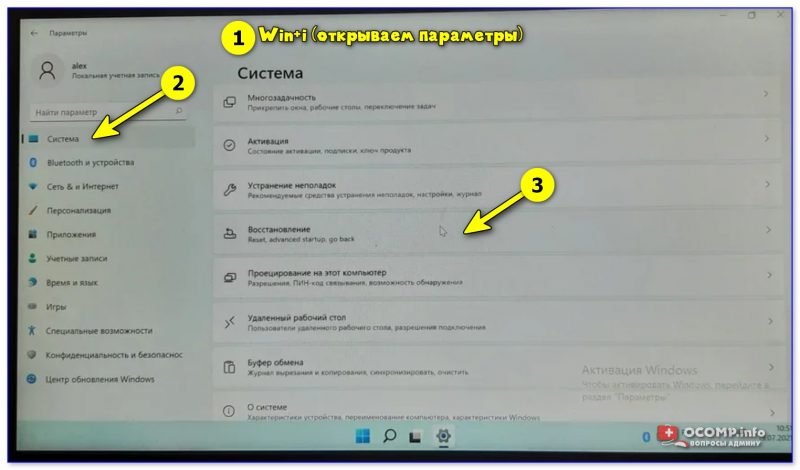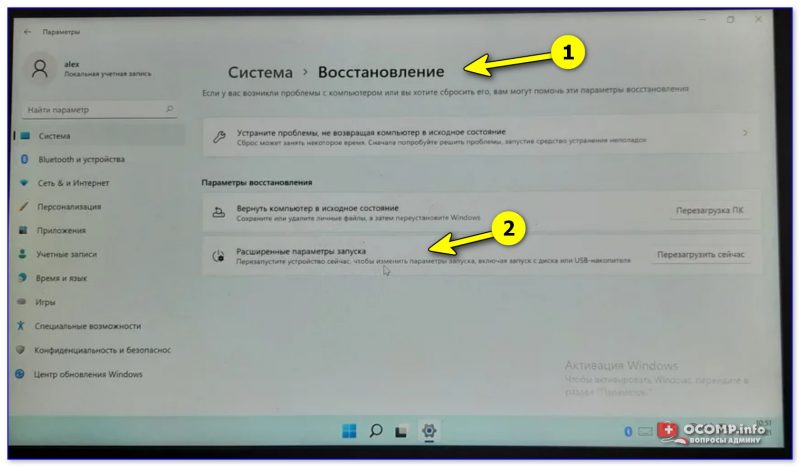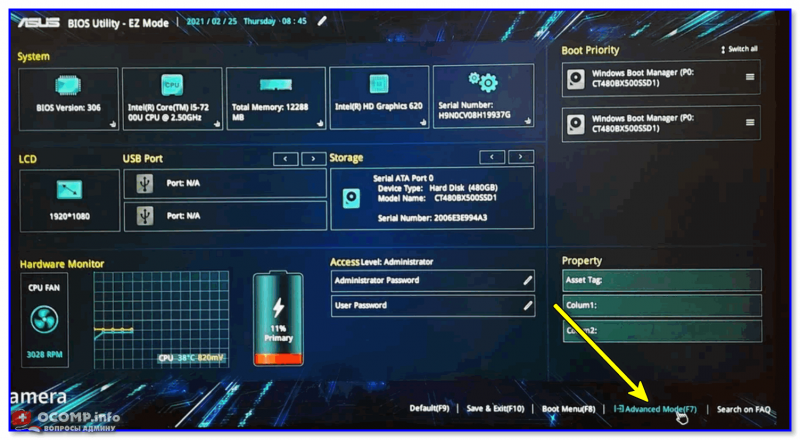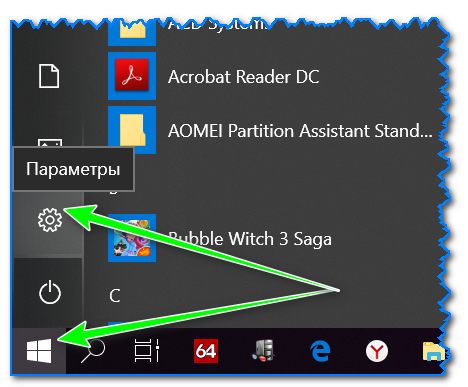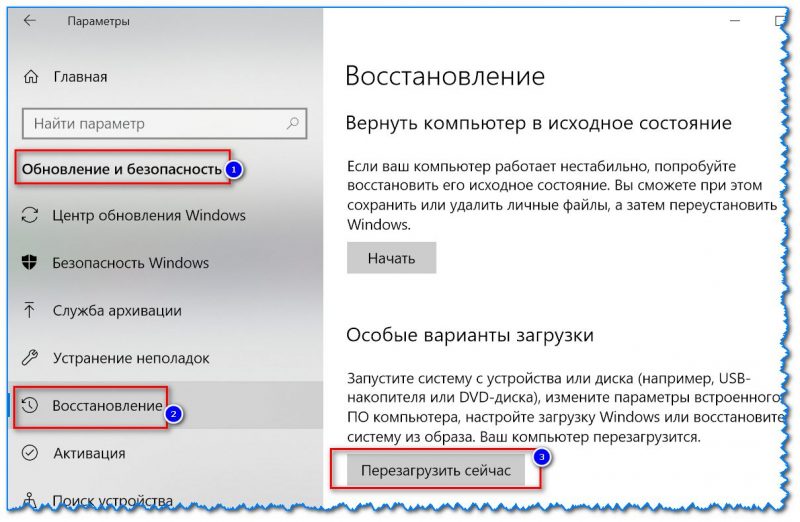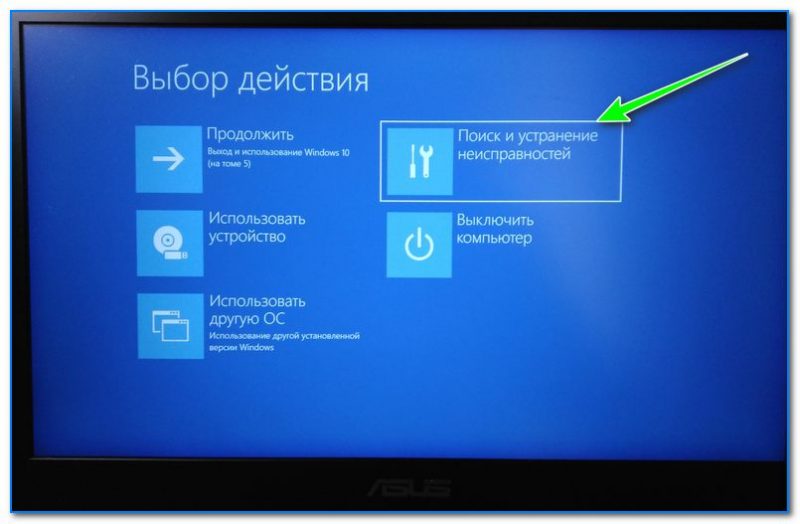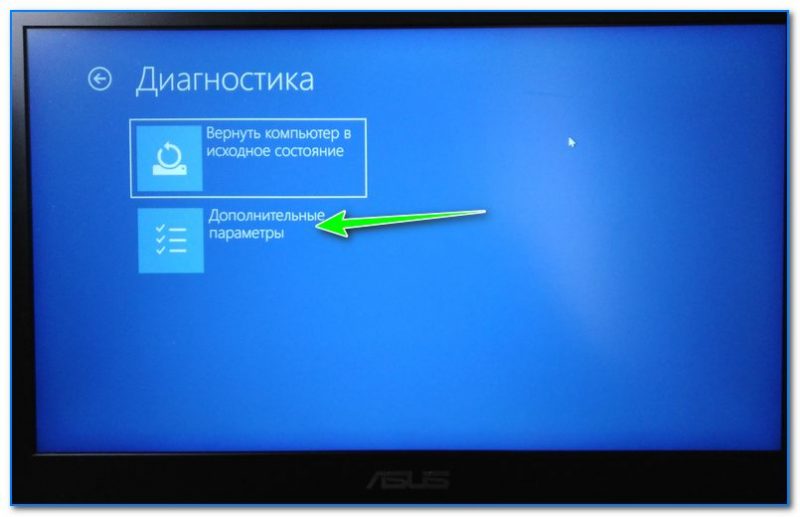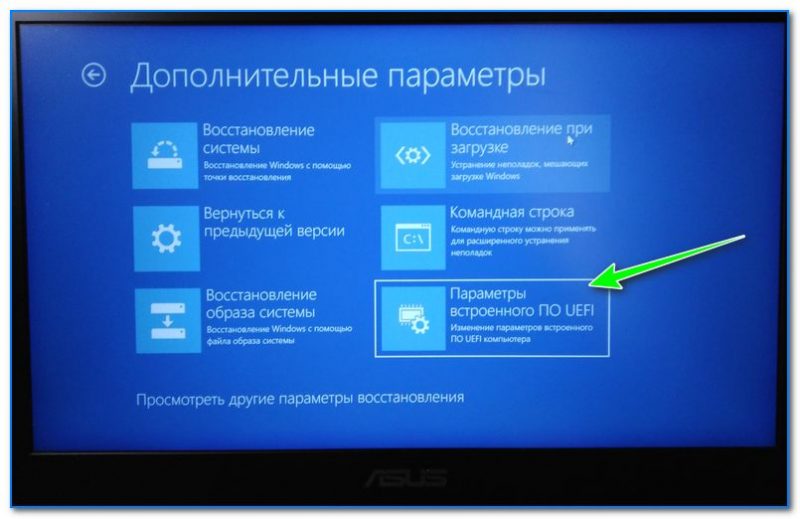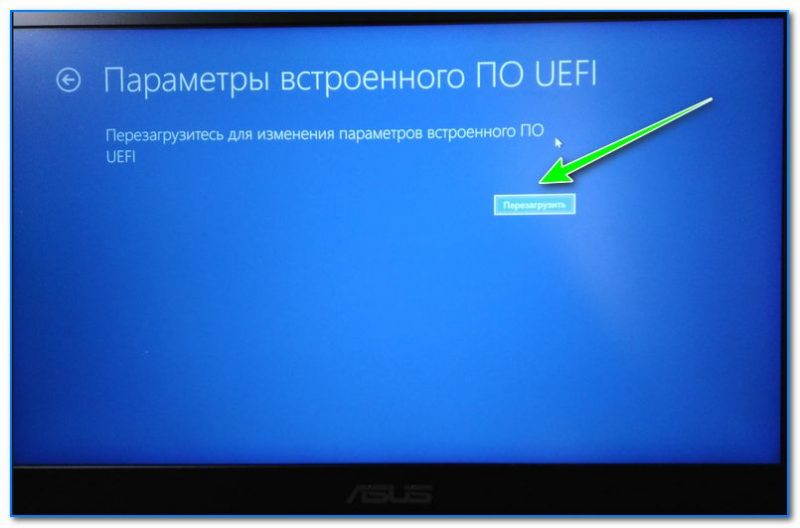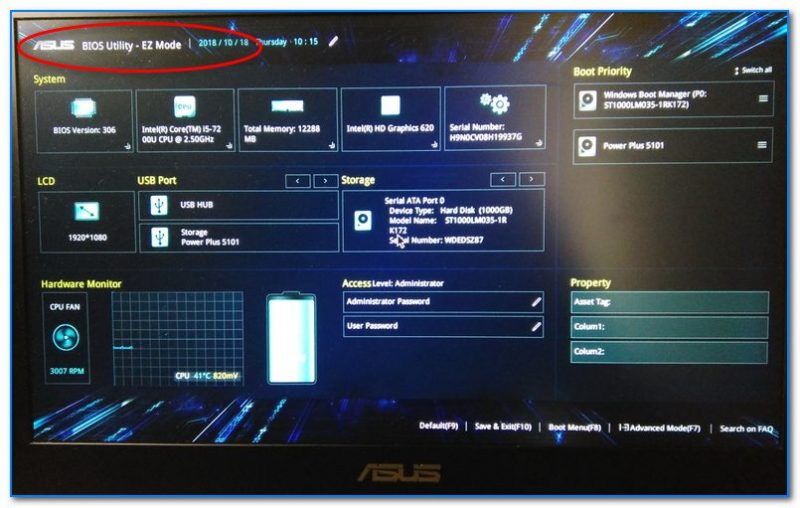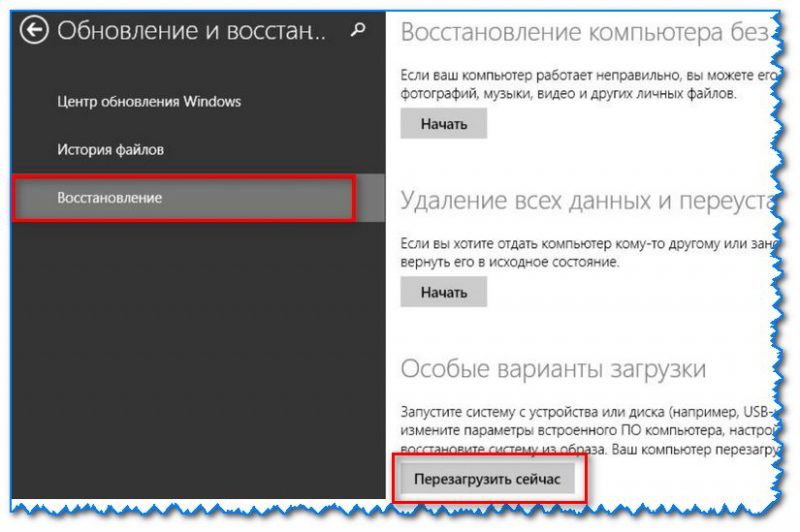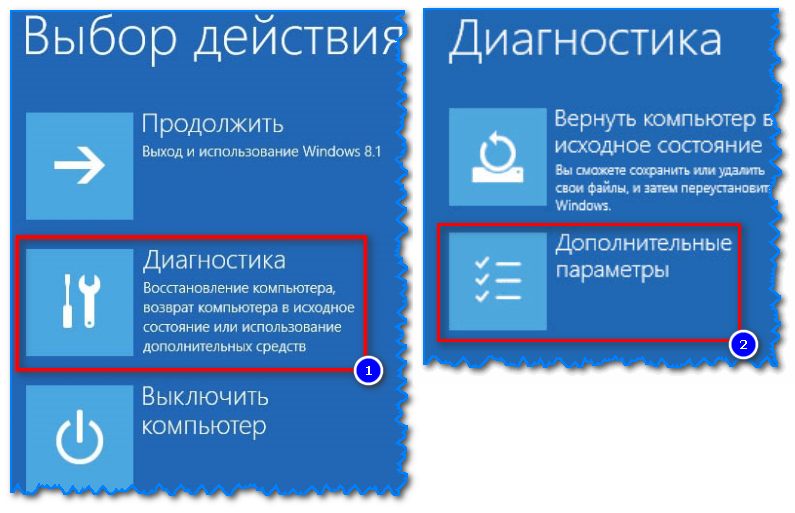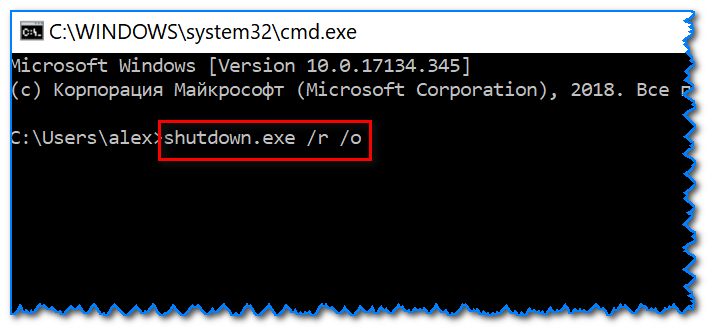Один из частых вопросов, касающихся последних версий ОС от Майкрософт, включая Windows 10 — как зайти в БИОС. При этом чаще имеется в виде все-таки UEFI (часто характеризующийся наличием графического интерфейса настроек), новый вариант ПО материнских плат, который пришел на замену стандартному БИОС, и предназначенный для того же — настройки работы оборудования, опций загрузки и получения информации о состоянии системы.
В связи с тем, что в Windows 10 (как и в 
Вход в параметры UEFI из Windows 10
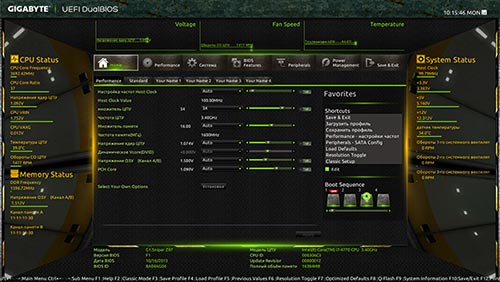
Для использования этого способа, Windows 10 должна быть установлена в режиме UEFI (как правило, так и есть), а вы должны иметь возможность либо войти в саму ОС, либо хотя бы попасть на экран входа в систему со вводом пароля.
В первом случае вам достаточно кликнуть по значку уведомлений и выбрать пункт «Все параметры». После чего в настройках открыть «Обновление и безопасность» и перейти к пункту «Восстановление».
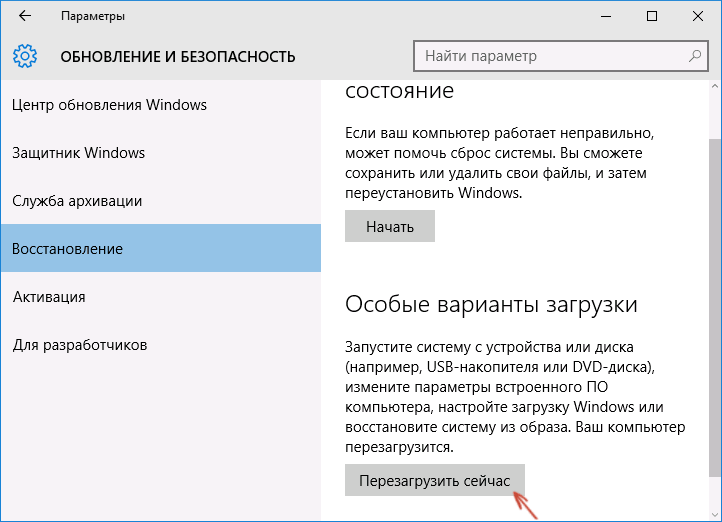
В восстановлении нажмите в разделе «Особые варианты загрузки» кнопку «Перезагрузить сейчас». После того, как компьютер перезагрузится, вы увидите экран такой же (или подобный) тому, что изображен ниже.
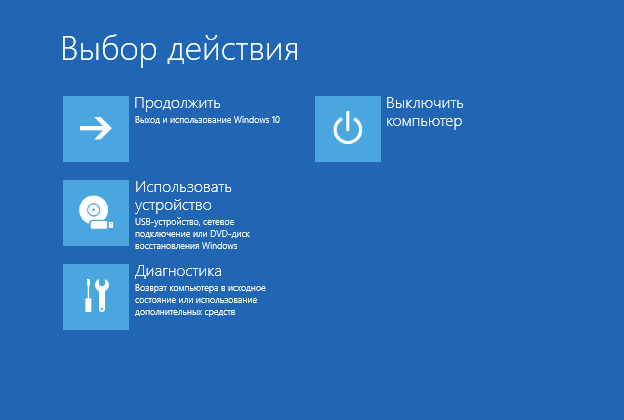
Выберите пункт «Диагностика», затем — «Дополнительные параметры», в дополнительных параметрах — «Параметры встроенного ПО UEFI» и, в завершение, подтвердите сове намерение, нажав кнопку «Перезагрузить».

После перезагрузки вы попадете в БИОС или, если точнее, UEFI (просто у нас по привычке настройки материнской платы обычно называют БИОС, наверное, так будет продолжаться и в дальнейшем).
В том случае, когда вы не можете войти в Windows 10 по каким-либо причинам, но можете попасть на экран входа, вы также можете зайти в настройки UEFI. Для этого, на экране входа в систему, нажмите кнопку «питание», а затем, удерживая клавишу Shift нажмите пункт «Перезагрузка» и вы попадете в особые варианты загрузки системы. Дальнейшие шаги уже были описаны выше.
Вход в БИОС при включении компьютера
Есть и традиционный, всем известный метод войти в БИОС (подходит и для UEFI) — нажать клавишу Delete (для большинства ПК) или F2 (для большинства ноутбуков) сразу при включении компьютера, еще до начала загрузки ОС. Как правило, на экране загрузки внизу отображается надпись: Press Название_Клавиши to enter setup. Если такой надписи нет, вы можете ознакомиться с документацией к материнской плате или ноутбуку, там должна присутствовать такая информация.
Для Windows 10 вход в БИОС этим способом это осложняется тем, что загрузка компьютера происходит действительно быстро, и не всегда эту клавишу можно успеть нажать (или даже увидеть сообщение о том, какую именно).
Для решения этой проблемы, вы можете: отключить функцию быстрой загрузки. Для этого, в Windows 10 кликните правой кнопкой мыши по кнопке «Пуск», выберите в меню «Панель управления», а в панели управления — электропитание.

Слева кликните «Действия кнопок питания», а на следующем экране — «Изменение параметров, которые сейчас недоступны».
Внизу, в разделе «Параметры завершения работы» уберите отметку «Включить быстрый запуск» и сохраните изменения. После этого, выключите или перезагрузите компьютер и попробуйте войти в БИОС с помощью необходимой клавиши.
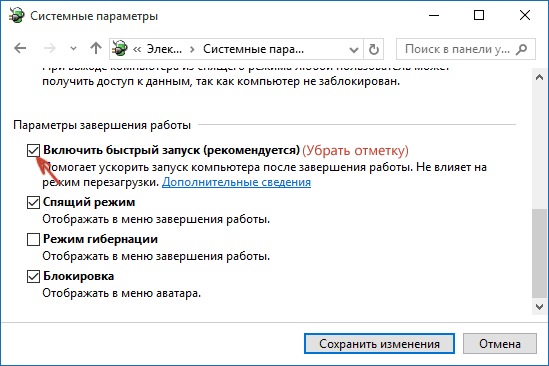
Примечание: в некоторых случаях, когда монитор подключен к дискретной видеокарте, вы можете не увидеть экран БИОС, а также информацию о клавишах для входа в него. В этом случае может помочь его переподключение к интегрированному графическому адаптеру (выходы HDMI, DVI, VGA на самой материнской плате).
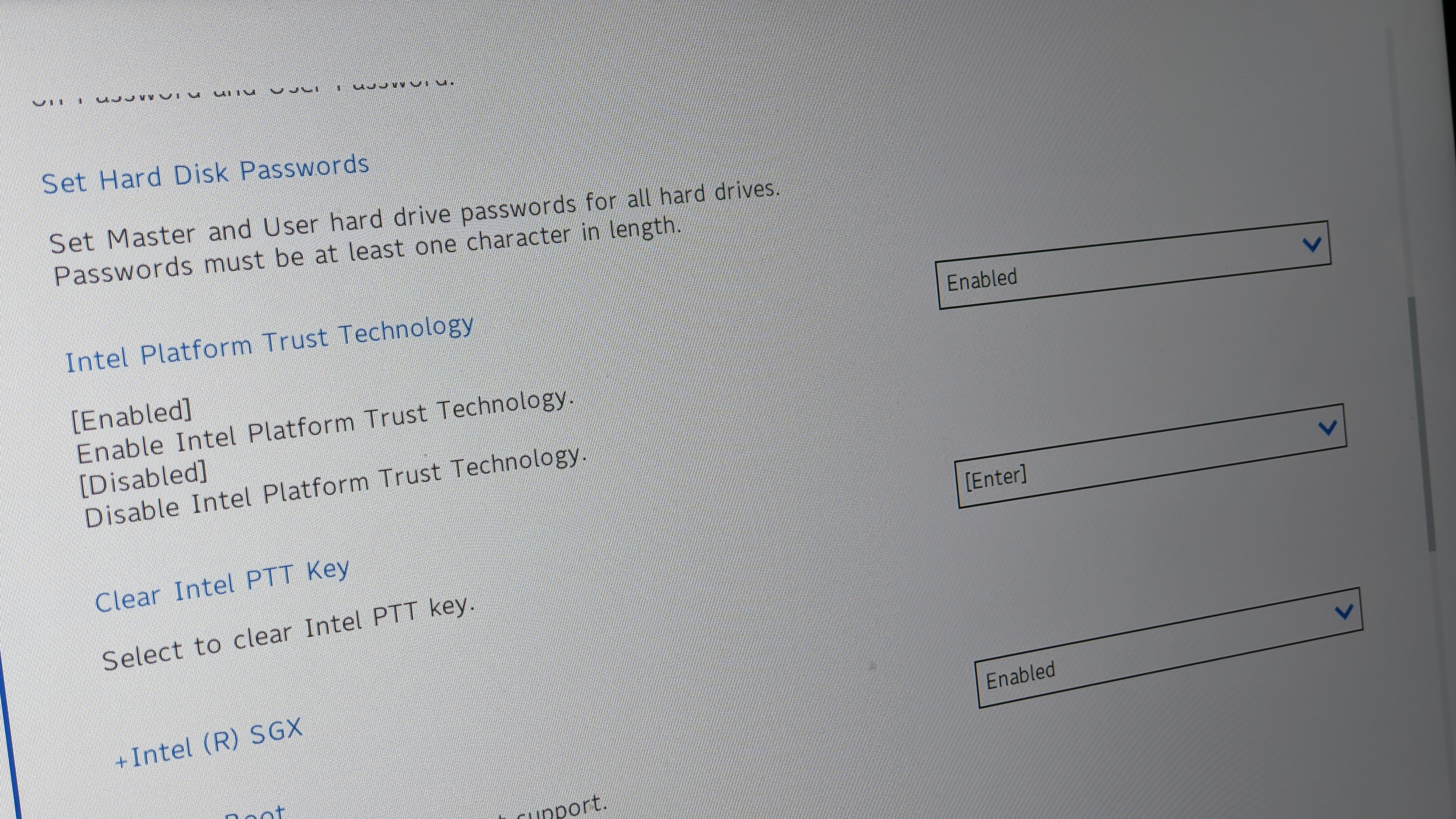
There are plenty of customizable settings within Windows 10, but some settings can only be changed in the BIOS, or the Basic Input-Output System. Within the BIOS, you can overclock your RAM, add a password for the BIOS, adjust fan settings, and so much more. But how do you enter the BIOS on Windows 10?
The BIOS is a pre-boot environment, as it’s firmware built directly into your computer’s motherboard. This means once you’re seeing Windows 10, you’ve gone too far. You need to access the BIOS before actually booting into Windows 10.
If you’re using an older computer (or one deliberately set to boot slowly), you can press the F1 or F2 key when powering on the computer to enter the BIOS. However, if you’re using a computer made within the past few years, it’ll likely boot too fast to register an F1/F2 keypress at startup. Instead, follow these easy steps to access the BIOS on your Windows 10 computer.
How to enter the BIOS on a Windows 10 PC
The simplest method of entering the BIOS on a Windows 10 PC is to simply hold down the Shift key while restarting your computer, which can be done by heading to the Start menu, clicking the power button, and selecting Restart.
When your computer restarts, you should see a blue screen with multiple options. If that’s the case, head to step 5. If you don’t see this blue screen and you’ve tried to access it multiple times with the above method, follow steps 1 through 4 instead.
1. Navigate to Settings. You can get there by clicking the gear icon in the Start menu.
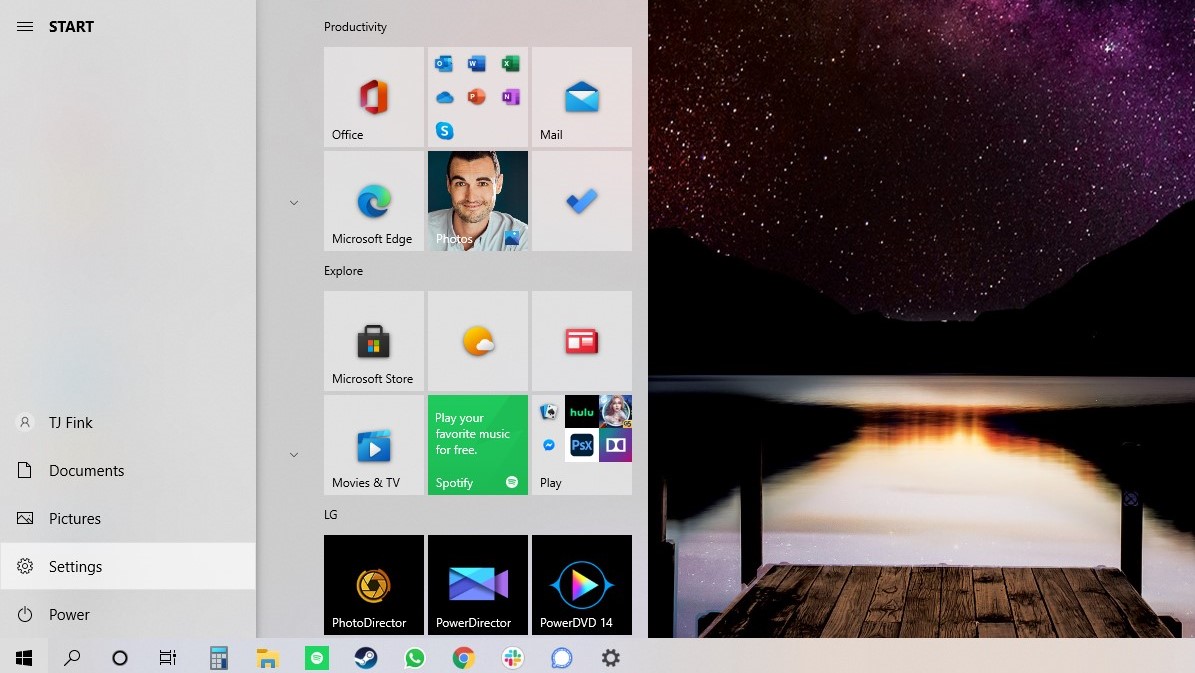
2. Select Update & Security.
Sign up to receive The Snapshot, a free special dispatch from Laptop Mag, in your inbox.
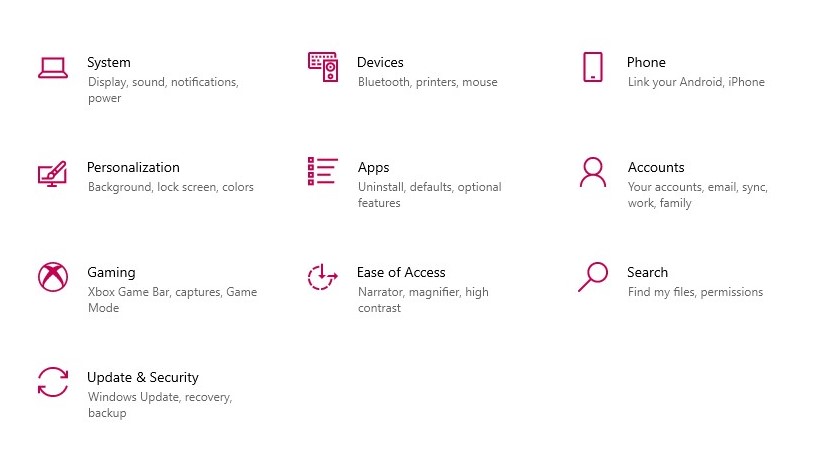
3. Select Recovery from the left menu.
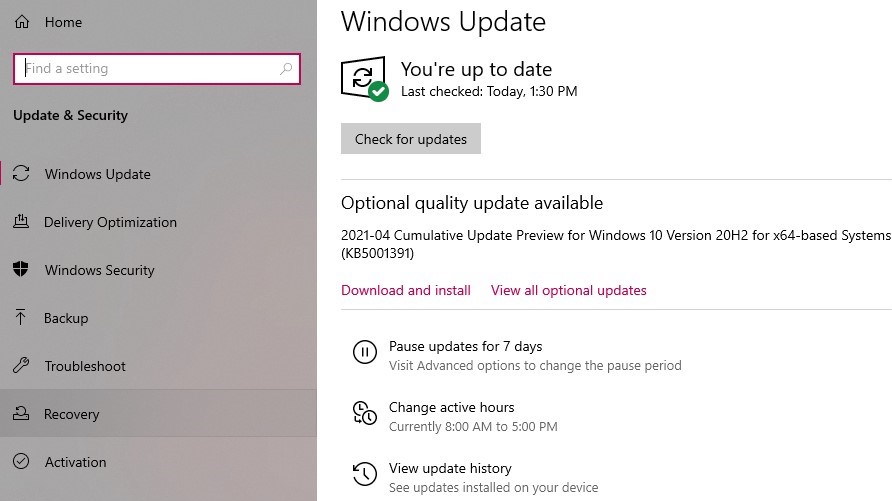
4. Click Restart Now under Advanced startup. The computer will reboot to a special menu.
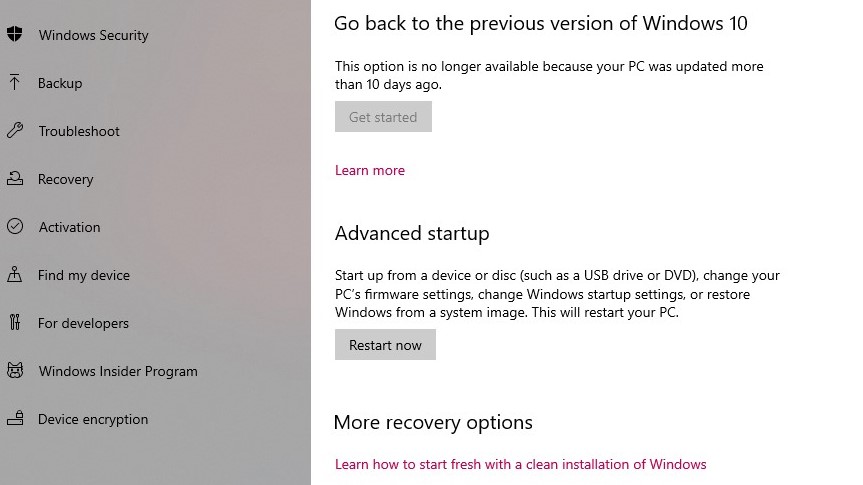
5. Click Troubleshoot.
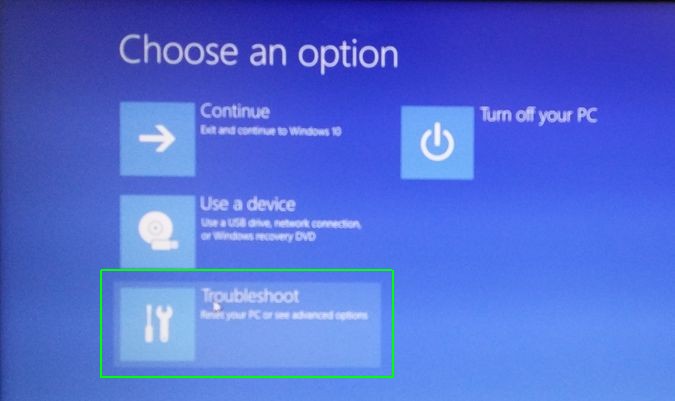
6. Click Advanced options.
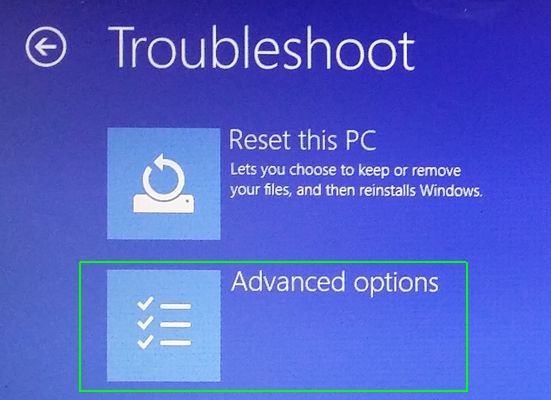
7. Select UEFI Firmware Settings. If you don’t see this icon, then press Startup Settings instead. When your PC is restarting, tap F1 (or F2) to access the BIOS.
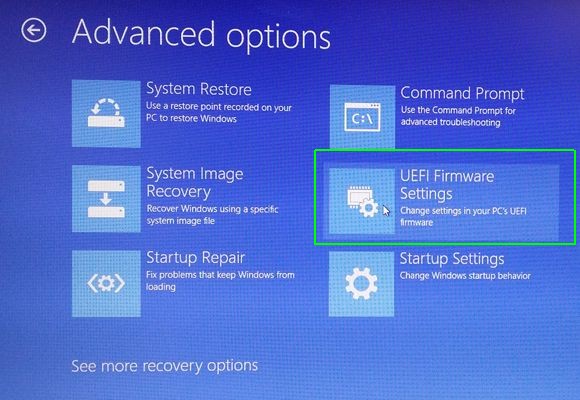
8. Click Restart.

Your system will restart and immediately take you to the BIOS. Accessing the BIOS requires intentional steps because it’s possible to change settings that’ll negatively affect your computer going forward. So before changing any settings, thoroughly research its possible effects and make sure it’s a change you definitely want to make.
Back to Apple MacBook Pro
Show more
The official Geeks Geek, as his weekly column is titled, Avram Piltch has guided the editorial and production of Laptopmag.com since 2007. With his technical knowledge and passion for testing, Avram programmed several of LAPTOP’s real-world benchmarks, including the LAPTOP Battery Test. He holds a master’s degree in English from NYU.
The BIOS (Basic Input/Output System) is a vital component of your computer that initializes hardware components such as the processor, memory and drives when you start the system. It acts as an interface between your computer’s hardware and software. If you Launch BIOS, you can configure settings like the boot order, and system time, and perform critical system optimizations. If you need to access these settings, here’s a detailed guide on how to run BIOS on Windows 10 and 11.
Table of Content
- What is BIOS?
- Method 1: Access BIOS at Startup
- Method 2: Access BIOS from Windows Settings
- Method 3: Access BIOS via Shift + Restart
- Method 4: Access BIOS Using Setup Key
- Method 5: Access BIOS Through Windows Command Prompt
- Method 6: Using the Run Dialog to Access BIOS
- Troubleshooting Tips
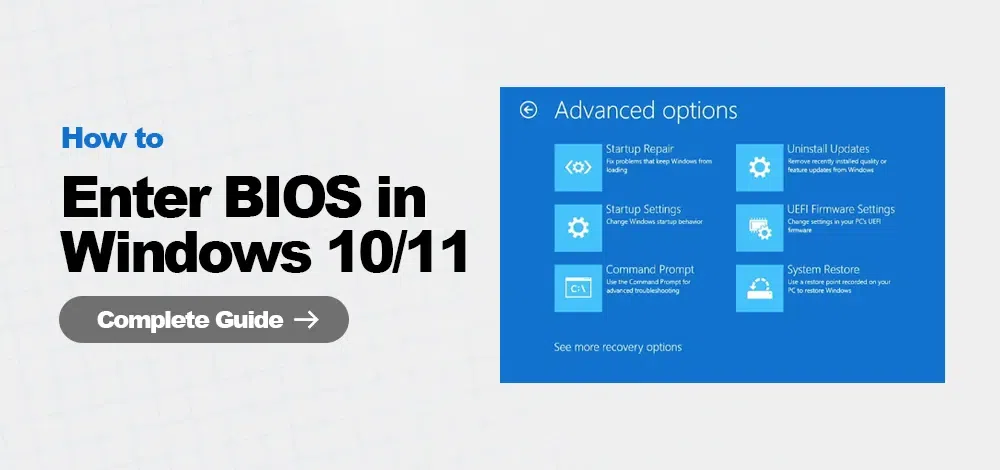
What is BIOS?
BIOS, or Basic Input/Output System, is firmware embedded in your computer’s motherboard. It plays an essential role during the boot process by initializing hardware, making it possible for the operating system to communicate with hardware components. Accessing the BIOS allows you to change several system settings, such as boot priority, security settings, and overclocking features.
While the steps provided here generally apply to most systems, some variations may exist based on the manufacturer and BIOS version. Some newer systems use UEFI (Unified Extensible Firmware Interface), which may have different methods for accessing and using the BIOS.
6 Methods to Enter BIOS Setup on Windows 10 & 11
The BIOS (Basic Input/Output System) or UEFI (Unified Extensible Firmware Interface) is an essential component of a computer. It helps control the hardware settings and enables the operating system to interact with various hardware components such as the CPU, memory, and storage devices. If you need to adjust certain system settings such as boot order, secure boot settings, or overclocking, entering the BIOS is necessary. Below are the various methods to access BIOS on Windows 10 and 11 systems.
Method 1: Access BIOS at Startup
The most traditional way to access BIOS is during the initial boot BIOS process. When you power on your PC, pressing a specific key immediately after the system starts will allow you to enter the BIOS.
Step 1: Restart your computer and immediately press the BIOS key
Simply start with restarting your computer and as soon as logo appear press the BIOS Key to enter the BIOS. The BIOS key can vary depending on your computer’s manufacturer. Common keys include Del, F2, F10, Esc, and F12. You’ll usually see a message on the screen that says, «Press [key] to enter setup» during boot. Make sure to press the key right after powering on, before Windows begins loading.
List of Common BIOS Keys:
- F2
- Delete (Del)
- Esc
- F10
- F12
- Ctrl+Alt+Del
- Ctrl+Alt+Esc
- Fn + F2 (for some laptops)
BIOS Keys List by Manufacturer
- Acer: F2 or Del
- ASUS: F2 (for most PCs), F2 or Del (for some motherboards)
- Dell: F2 or F12
- HP: F10
- Lenovo: F1 (desktops), F2 or Fn+F2 (laptops), Enter then F1 (ThinkPads)
- MSI: Del
- Microsoft Surface Tablets: Volume Up button
- Samsung: F2
- Toshiba: F2
Step 2: Wait for the BIOS screen to appear
Once you’ve successfully pressed the key, you should see the BIOS or UEFI interface. Here, you can configure settings like boot order, secure boot, or system time.
Additional Tip: If you miss the timing and Windows starts loading, simply restart the system and try again.
Method 2: Access BIOS from Windows Settings
In Windows 10 and 11, you can access the BIOS directly from the Settings menu. This is a particularly useful method if you can’t access BIOS using the traditional key press at startup.
- Press Windows + I to open the Settings app.
- Alternatively, you can click on the Start menu and select Settings.
Step 2: Navigate to Update & Security
In the Settings window, go to Update & Security and select Recovery from the left sidebar.
Step 3: Click on Restart Now under Advanced Startup
Under the Advanced Startup section, click on Restart Now. This will restart your PC into a special menu for advanced troubleshooting.
Step 4: Select UEFI Firmware Settings and Restart
Once your computer restarts, you will be presented with a menu. Choose Troubleshoot > Advanced Options > UEFI Firmware Settings, then click on Restart.
Important Tip: This method is helpful if you are unable to press the BIOS key in time during boot-up.
Method 3: Access BIOS via Shift + Restart
You can use the Shift + Restart combination to access the BIOS without needing to navigate through the Settings menu. This method is particularly useful for users who find it difficult to press the BIOS key at the correct time.
In the Start menu, click on the Power button.
Step 2: Hold down the Shift key and click Restart
Hold the Shift key on your keyboard and then click Restart from the power options. This will initiate the Advanced Startup menu.
Step 3: Navigate to UEFI Firmware Settings
After your system restarts, select Troubleshoot > Advanced Options > UEFI Firmware Settings and click Restart
Additional Tip: This method works on both Windows 10 and Windows 11, providing a way to access BIOS without using the BIOS key during startup.
Method 4: Access BIOS Using Setup Key
On some computers, especially newer ones, you may be able to access BIOS using a «Setup» key, typically during the initial boot sequence. This method is usually available for systems with UEFI firmware.
Step 1: Power off your computer
Ensure your PC is completely powered off before proceeding.
Step 2: Press the Setup key when turning on the computer
Turn on the computer, and immediately press the Setup key (commonly F2, F12, or Del) when the manufacturer logo appears.
Here’s a list of common BIOS setup keys by manufacturer:
Desktop PCs BIOS Setup Key List
- Acer: F2 or Del
- ASRock: F2 or Del
- ASUS: F2 or Del
- Dell: F2 or F12
- ECS: Del
- Gigabyte: F2 or Del
- HP: F10
- Lenovo: F1
- MSI: Del
- Samsung: F2
Laptops BIOS Setup Key List
- Acer: F2
- ASUS: F2
- Dell: F2
- HP: F10
- Lenovo: F2 or Fn+F2
- MSI: Del
- Samsung: F2
- Toshiba: F2
Other Devices BIOS Setup Key List
- Microsoft Surface Tablets: Volume Up button
- Apple MacBooks: Command + Option + P + R
Step 3: Wait for BIOS Setup to appear
After pressing the key, the BIOS setup screen should appear, allowing you to make changes to your system settings.
Tip: If you do not see the prompt for the Setup key, you can refer to your computer’s manual or the manufacturer’s website for the exact key to press.
Method 5: Access BIOS Through Windows Command Prompt
Another option to access BIOS is by using the Command Prompt to initiate a restart into Advanced Startup. This is an ideal method for users who prefer using commands or need an alternative method when other approaches fail.
Step 1: Open Command Prompt as Administrator
Press Windows + X and select Command Prompt (Admin) or Windows PowerShell (Admin) from the menu.
Step 2: Enter the Command to Restart into Advanced Startup
Type the following command and press Enter:
shutdown /r /o /f /t 00
This command will restart your computer into the Advanced Startup Options screen.
Step 3: Select UEFI Firmware Settings and Restart
From the Advanced Startup Options menu, select Troubleshoot > Advanced Options > UEFI Firmware Settings, and then click on Restart.
Important Tip: This method is especially useful if you’re comfortable with using the Command Prompt and need a quick way to access BIOS.
Method 6: Using the Run Dialog to Access BIOS
This method allows you to access BIOS via the Run dialog box, which is another way to reach the Advanced Startup Options.
Step 1: Press Windows + R to open the Run dialog
In the Run dialog box, type msconfig and hit Enter.
Step 2: Go to the Boot Tab in System Configuration
In the System Configuration window, click on the Boot tab.
Step 3: Enable Safe Boot and Restart
Check the Safe Boot option, click OK, and restart your computer. This will bring up the Advanced Startup Options menu.
Step 4: Navigate to UEFI Firmware Settings
From the restart menu, choose Troubleshoot > Advanced Options > UEFI Firmware Settings and click Restart.
Troubleshooting Tips
- BIOS Key Not Working: If you’re unable to press the correct key at startup, it might be too fast. Try enabling the Fast Boot option in your BIOS or adjusting the Boot Priority in the UEFI firmware settings.
- No BIOS Option Displayed: If you don’t see the BIOS option when pressing the key or using the methods above, it could be that your system uses UEFI. Make sure to access the UEFI Firmware Settings instead.
- Cannot Access BIOS After Multiple Attempts: If you’re unable to enter BIOS after several tries, make sure your keyboard is connected properly, especially if you’re using a wireless or USB keyboard. Wired keyboards are generally more reliable during the boot process.
Conclusion
Accessing the BIOS on Windows 10 and 11 can be done in several ways depending on the manufacturer and your system configuration. Whether you use the traditional key press method or one of the alternative options available within Windows, each method provides a reliable way to access critical system settings. Always proceed with caution when making changes in the BIOS, as improper settings can cause system instability. If you’re unsure about a specific setting, it’s best to consult your system manual or manufacturer’s support page.
Доброго времени!
Не многие пользователи знают, что в UEFI (BIOS) можно войти без использования и нажатия спец. клавиш (тех же Delete или F2). Это очень может выручить, если вы перебрали все возможные кнопки, а компьютер никак не реагирует на ваши нажатия…
Отмечу, что воспользоваться этим способом можно только при условиях, что:
- у вас установлена современная ОС Windows 8, 8.1, 10, 11 (в остальных данной возможности нет);
- ваша мат. плата должна поддерживать UEFI (если ваш ПК/ноутбук не старше 3-4 лет — то наверняка поддержка есть!);
- ОС должна загружаться и «хоть как-то» работать (если же ОС не установлена — рекомендую ознакомиться со справочной статьей с кнопками входа в BIOS для устройств разных производителей).
*
Итак, теперь ближе к теме…
*
Из Windows 11
Все действия рассмотрю по шагам (для большей наглядности и доступности).
- для начала необходимо открыть параметры Windows и перейти в раздел «Система / восстановление» (сочетание клавиш Win+i // либо Win+R, и команда «ms-settings:» (без кавычек));
Открываем параметры Windows 11 — вкладку восстановление
- далее согласиться на перезагрузку и запуск ПК с расширенными параметрами. См. пример ниже на фото; 👇
Расширенные параметры запуска
- после перезагрузки появится «синее меню»: в нем нужно будет выбрать вариант «Поиск и устранение неисправностей / доп. параметры / Параметры встроенного ПО UEFI»; 👇
Параметры встроенного ПО
- ну и после еще одной перезагрузки — появится окно BIOS (UEFI). Можно приступить к настройкам! 👌
UEFI (Asus) — Advanced Mode
*
Из Windows 10
- Сначала необходимо зайти в параметры Windows (можно использовать сочетание Win+i, можно воспользоваться меню ПУСК);
Параметры (Windows 10)
- далее необходимо открыть раздел «Обновление и безопасность/Восстановление» и найти подраздел «Особые варианты загрузки»: нажать в нем кнопку «Перезагрузить сейчас». См. пример ниже (цифры 1, 2, 3); 👇
Обновление и безопасность — восстановление (кликабельно)
- после чего откройте раздел «Поиск и устранение неисправностей»;
Выбор действия (Windows 10)
- затем подраздел «Дополнительные параметры»;
Диагностика — доп. параметры
- далее вкладку «Параметр встроенного ПО UEFI» (пример на фото ниже 👇);
Параметры встроенного ПО
- ну и последнее, что осталось — это согласиться на перезагрузку; 👇
Перезагрузить
- после перезагрузки компьютера (ноутбука) у вас автоматически будет осуществлен вход в настройки UEFI (пример ниже 👇). Никаких кнопок дополнительно нажимать не нужно!
BIOS Utility — вход выполнен
*
Из Windows 8, 8.1
В принципе действия аналогичны, правда, интерфейс несколько отличается от Windows 10.
- сначала передвиньте ползунок мышки вправо, чтобы появилось боковое меню: выберите «Параметры» (см. скрин ниже 👇);
Windows 8 — параметры
- далее щелкните по ссылке «Изменение параметров компьютера»;
Изменение параметров компьютера
- затем откройте раздел «Обновление и восстановление»;
Обновление и восстановление
- после чего в разделе «Восстановление» найдите подраздел «Особые варианты загрузки» и щелкните по кнопке «Перезагрузить сейчас»; 👇
Восстановление — перезагрузить сейчас
- далее компьютер будет перезагружен, и вы увидите меню с выбором действия: откройте вкладку «Диагностика», затем «Доп. параметры»; 👇
Выбор действия — диагностика
- затем «Параметры встроенного ПО UEFI» и согласитесь на перезагрузку: после нее компьютер сам автоматически откроет настройки UEFI (BIOS). 👇
Параметры встроенного ПО (Windows
*
С помощью командной строки, меню ПУСК
👉 Командная строка
- открываем командную строку (если не знаете как — см. вот эту инструкцию);
- далее нужно ввести команду shutdown.exe /r /o и нажать Enter;
shutdown.exe в командной строке
- после чего увидите сообщение, что через минуту ваш сеанс будет завершен;
Ваш сеанс будет завершен
- по прошествии этой минуты, вы увидите меню с выбором действия (дальше действия аналогичны предыдущим описываемым шагам, см. выше). 👇
Выбор действия
*
Меню ПУСК
Еще один альтернативный вариант — это зайти в меню ПУСК, нажать по кнопке «Выключения», после зажать клавишу SHIFT и выбрать вариант «Перезагрузка». Дальнейшие действия аналогичны предыдущим шагам.

SHIFT + Перезагрузка
*
Дополнения по теме приветствуются…
Удачной работы.
👋
Первая публикация: 18.10.2018
Корректировка: 9.07.2021
Download Article
Quickly access the BIOS or UEFI settings on Windows 10, 11, and 8
Download Article
- Using the Setup Key
- Using Windows 10 & 11 Settings
- Using the Windows Login Screen
- Using Windows 8 and 8.1 Settings
- Troubleshooting
- Video
- Q&A
- Tips
|
|
|
|
|
|
|
Do you need to change your PC’s boot order, or reset your system clock? Once you learn how to access your computer’s BIOS (Basic Input Output System) or UEFI (Unified Extensible Firmware Interface), making changes to the configuration is quick and easy. Entering the BIOS or UEFI varies from computer to computer, but the basic process is always the same. This wikiHow article will teach you easy ways to enter the BIOS on any Windows PC using a setup key or through your Windows settings. We’ll also help you troubleshoot and fix common problems that prevent you from entering the BIOS.
Quick Steps
- Reboot your computer.
- As soon as the manufacturer’s logo appears, press the setup key repeatedly.
- Common setup keys are F1, F2, Del, F10, F12, or Esc.
- Navigate the BIOS menus using the arrow keys and Enter key.
-
your computer. One way to enter the BIOS is to use your computer’s setup key—a keyboard key you’ll press as soon as your computer restarts.
- Entering the BIOS requires you to restart your PC. Save your work and shut down other programs before continuing this method.
-
As soon as you see the manufacturer’s logo, press the key indicated on the screen to enter Setup or BIOS. The key you’ll need to use varies by manufacturer and model. Keep pressing it over and over again until you enter the BIOS.
- Here’s a list of some of the most common setup keys by manufacturer:
- Acer: F2 or Del
- ASUS: F2 or Del
- Dell: F2 or F12
- HP: ESC or F10
-
Lenovo Desktops: F1 or F2 (hold down the Fn key if your F keys are blue or orange)[1]
-
Lenovo IdeaPad: F9 or Fn + F9[2]
-
Lenovo ThinkPad, ThinkCentre, & ThinkStation: F1 or Enter[3]
- MSI: Del for both MSI motherboards and PCs
- Microsoft Surface Tablets: Press and hold the volume-up button.
- Origin PC: F2
- Samsung: F2
- Sony: F1, F2, or F3
- Toshiba: F2
- If you don’t hit the key in time, Windows will load, and you will have to reboot and try again.
- Sometimes Windows will boot so quickly that you won’t have time to enter the BIOS using the setup key. If this happens, you can enter the BIOS from the Windows desktop.
Advertisement
- Here’s a list of some of the most common setup keys by manufacturer:
-
If you press the correct key, the BIOS or UEFI will load. If your mouse isn’t working in the BIOS, you can navigate menus using your keyboard.
Advertisement
-
If you can boot into Windows, you should be able to enter the UEFI/BIOS without worrying about pressing special keys at boot time.[4]
- Entering the BIOS requires you to restart your PC. Save your work and shut down other programs before continuing this method.
-
On Windows 10, it’s the icon of two curved arrows. On Windows 11, «System» is an option in the left sidebar.
-
It’s in the left column on Windows 10, and in the right panel on Windows 11.
-
It’s in the right panel, although you may need to scroll down a little to find the button.
-
Additional menu options will appear.
-
It’s the icon of a microchip with a gear on it. A confirmation screen will appear.
- If you don’t see this option, you’ll need to use the Using the Setup Key method.
-
This will restart your PC into the BIOS/UEFI.
- Once you’re in the BIOS or UEFI, use the arrow keys on your keyboard (or your mouse, if it works) to navigate and make menu selections.[5]
- Once you’re in the BIOS or UEFI, use the arrow keys on your keyboard (or your mouse, if it works) to navigate and make menu selections.[5]
Advertisement
-
If you can’t sign in to Windows, you can still enter the BIOS from the login screen. If you’re currently signed into an account, you’ll need to log out to use this method.
-
Do not release the Shift key yet.
-
Your PC will reboot to a blue screen with several options.
-
Additional menu options will appear.
-
It’s the icon of a microchip with a gear on it. A confirmation screen will appear.
- If you don’t see this option, you’ll need to use the Using the Setup Key method.
-
This will restart your PC into the BIOS/UEFI.
- Once you’re in the BIOS or UEFI, use the arrow keys on your keyboard (or your mouse, if it works) to navigate and make menu selections.
Advertisement
-
You can do this by holding the mouse cursor at the bottom-right corner of your desktop.
- Entering the BIOS requires you to restart your PC. Save your work and shut down other programs before continuing this method.[6]
- Entering the BIOS requires you to restart your PC. Save your work and shut down other programs before continuing this method.[6]
-
It’s the gear icon on the Charms bar.
-
It’s at the bottom of the menu.
-
It’s at the bottom of the left panel.
- If you’re using Windows 8 and haven’t updated to 8.1, select General in the left panel instead.[7]
- If you’re using Windows 8 and haven’t updated to 8.1, select General in the left panel instead.[7]
-
It’s on the left panel.
-
It’s under the «Advanced Setup» header in the right panel.
-
It’s the second option.
-
It’s the last option.
-
It’s the icon of a microchip with a gear on it. A confirmation screen will appear.
- If you don’t see this option, you’ll need to use the Using the Setup Key method.
-
This option will restart your PC into the BIOS/UEFI.
- Once you’re in the BIOS or UEFI, use your mouse to navigate and make menu selections. [8]
- Once you’re in the BIOS or UEFI, use your mouse to navigate and make menu selections. [8]
Advertisement
-
If Fast Startup is enabled, you likely won’t be able to enter the BIOS by pressing your computer’s setup key because it’ll boot up too fast. You can disable Fast Startup to fix this, or use a different method to enter the BIOS. To disable Fast Startup:
-
Windows 11:
- Type choose a power plan into the Windows search bar and click Choose a power plan in the search results.
- Click Choose what the power button does in the left panel.
- Uncheck «Turn on fast startup.» If it’s grayed out, click Change settings that are currently unavailable first.
- Click Save changes.[9]
-
Windows 10:
- Type power and sleep into the Windows search bar and click Power & sleep settings.
- Click Additional power settings under «Related settings.»
- Click Choose what the power button does in the left panel.
- Uncheck «Turn on fast startup.» If it’s grayed out, click Change settings that are currently unavailable first.
- Click Save changes.
-
Windows 11:
-
This usually happens when the BIOS doesn’t support the resolution of your monitor or there’s an unsupported device connected to your PC. Try connecting a different monitor to your computer, and make sure no external devices other than your mouse and keyboard are connected when you try to enter the BIOS.
-
This could happen for a few reasons:
- Different motherboards use different setup keys, so you may just be using the wrong one. If your computer was prebuilt by an OEM manufacturer like Dell, HP, or Lenovo, look up your model and «Setup key» or «BIOS key» to find the right setup key.
- If you’re using the right key but it’s not working, you may need to hold down Fn as you press it.
- As soon as the computer turns off and back on, press the setup key repeatedly, but don’t hold it down. Press it over and over again quickly until it boots to the BIOS or a menu with an option to enter it.
- If you’re using a Lenovo laptop or desktop computer, try pressing Enter as soon as you see the Lenovo logo to enter the Startup Interrupt Menu. When the menu loads, press F1 to enter the BIOS setup utility.
-
You can reset the BIOS to its default settings by removing the CMOS battery for about 5 minutes and then reconnecting it, or by temporarily moving the CMOS jumper slider to a different position.
-
Removing/replacing the CMOS battery:
- Turn off your PC and disconnect all cables and peripherals.
- Open your computer and locate the CMOS battery on the motherboard. It’s a round battery in a horizontal or vertical battery holder, or sometimes connected to a header with a wire.[10]
- If the CMOS battery is in a holder, take a photo so you can remember which direction it’s inserted in, then remove it from the holder for about 5 minutes before replacing it.
- If it’s connected with a wire, disconnect the wire for about 5 minutes, then reconnect it.
- Reboot and enter the BIOS.
-
Resetting with a jumper:
- Turn off your PC and disconnect all cables and peripherals.
- Locate the 3 pins near the CMOS battery, a round disc-style battery.
- The jumper should have two positions—1-2, and 2-3. The default position is 1-2.
- Move the jumper to 2-3 and leave it in place for 5 minutes.
- Move the jumper back to the default position, reboot, and enter the BIOS.
-
Removing/replacing the CMOS battery:
Advertisement
Add New Question
-
Question
How do I reset BIOS with an external monitor?
1: Power on. 2: Press Fn + F8. 3: Press F2 or Delete key depending on your notebook to enter BIOS. (You can do 3 before 2.)
-
Question
How can I get in if I do not know the password?
You can’t. The BIOS has been designed to require a password to deter potential hackers.
-
Question
How do I enter BIOS on a Windows 7 computer?
Siemen360
Community Answer
The operating system is irrelevant. Google your PC manufacturer or motherboard to find out what key to press on your keyboard. Once you know it, reboot your PC and press the key to enter the BIOS as soon as your PC powers on and the logo of your manufacturer shows.
See more answers
Ask a Question
200 characters left
Include your email address to get a message when this question is answered.
Submit
Advertisement
Video
-
If the BIOS keeps resetting to its default settings, you may need to replace the CMOS battery.
-
Don’t change any settings with the BIOS unless you are sure about what you are doing.
Tips from our Readers
The advice in this section is based on the lived experiences of wikiHow readers like you. If you have a helpful tip you’d like to share on wikiHow, please submit it in the field below.
- If you need to reset the BIOS because you don’t have the password, you’ll lose any custom BIOS settings you’ve added. So, if you set the optical drive as the first device in the boot order, you’ll need to make that change again after resetting the BIOS.
- If your computer has a BIOS, the mouse won’t be usable. If you have a UEFI, you should be able to use the mouse.
Thanks for submitting a tip for review!
Advertisement
About This Article
Article SummaryX
1. Open your Windows Settings.
2. Click Update & Security.
3. Click Recovery.
4. Click Restart Now.
5. Click Troubleshoot.
6. Click UEFI Firmware Settings.
7. Click Restart.
Did this summary help you?
Thanks to all authors for creating a page that has been read 1,340,974 times.

